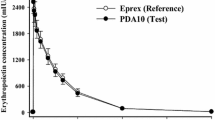Abstract.
Objective: To compare the pharmacokinetics, pharmacodynamics, and tolerance of epoetin alfa administered subcutaneously (s.c.) once weekly (q.w.) and three times weekly (t.i.w.). Methods: An open-label, randomized, parallel-design study was conducted in 36 healthy adults with hemoglobin (Hb) levels of 11.7–14.0 g/dl for women and 13.0–14.8 g/dl for men. Subjects were randomized to epoetin alfa 150 IU/kg s.c. t.i.w. or 40,000 IU s.c. q.w. for 4 weeks. Serum erythropoietin concentrations were measured using a validated enzyme-linked immunosorbent assay (ELISA). Pharmacokinetic parameters [peak serum concentration (Cmax), mean predose trough concentration (Cmin), time to Cmax (tmax), clearance after s.c. administration (CL/F), area under the plasma concentration–time curve (AUC), and terminal elimination half-life (t 1/2)] were calculated using model-independent methods. Mean changes from baseline and AUC of percentage reticulocytes, Hb, and total red blood cell (RBC) concentrations over the 1-month study period were calculated. Results: The Cmax values for serum epoetin alfa q.w. were six times and AUC(0–168) values three times that of the t.i.w. regimen. Time profiles of changes in percentage reticulocytes, Hb, and total RBC over 1 month were similar between regimens. The rate of increase in Hb was similar for the two groups, and both groups exhibited a 3.1-g/dl increase in mean Hb levels from baseline through day 29. Changes in ferritin levels were generally similar between groups and reflected expected use of iron stores for Hb production. Epoetin alfa administered t.i.w. or q.w. was well tolerated and no serious adverse events occurred. Conclusion: The pharmacodynamic responses were equivalent between groups despite expected differences in total erythropoietin exposure. These results indicate that the epoetin alfa 150 IU/kg t.i.w. and 40,000 IU q.w. regimens can be considered clinically equivalent.
Similar content being viewed by others
Author information
Authors and Affiliations
Additional information
Accepted in revised form: 11 May 2001
Electronic Publication
Rights and permissions
About this article
Cite this article
Cheung, W., Minton, N. & Gunawardena, K. Pharmacokinetics and pharmacodynamics of epoetin alfa once weekly and three times weekly. Eur J Clin Pharmacol 57, 411–418 (2001). https://doi.org/10.1007/s002280100324
Received:
Published:
Issue Date:
DOI: https://doi.org/10.1007/s002280100324




